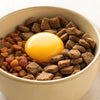How to Wean a Dog Off Raw Food: A Comprehensive Guide for Pet Owners
- Houndsy
Table of Contents
- Introduction
- Understanding Raw Food Diets for Dogs
- Reasons for Weaning a Dog Off Raw Food
- Methods to Wean a Dog Off Raw Food
- Monitoring Health During Transition
- Transitioning Tips and Tricks
- Conclusion
- FAQ Section
Introduction
Switching a dog off raw food can feel like a daunting task, especially when you consider the diverse opinions surrounding canine nutrition. With 32% of dog owners prioritizing health and wellness in their pet's diet according to Mintel’s 2023 UK Pet Food report, it’s crucial to ensure that every feeding decision fosters your dog's well-being. For some pet owners, transitioning away from raw food may become necessary due to various reasons, whether it’s convenience, dietary shift, or veterinary advice. The aim of this blog post is to provide you with a structured, step-by-step guide on how to wean a dog off raw food effectively, what changes to expect during the process, and how to maintain your dog’s overall health during this transition.
We’ll cover everything from understanding the nutritional implications of a raw food diet, the potential reasons and methods for weaning a dog off it, and helpful tips to make the process smoother for both you and your pet. As we delve into this topic, we invite you to reflect on your own feeding routines and consider how they influence your dog’s health and happiness. By the end of this post, you will be equipped with practical knowledge to ensure a seamless transition for your furry friend.
Understanding Raw Food Diets for Dogs
Before we dive into how to wean a dog off raw food, it’s essential to comprehend what a raw food diet entails. Raw diets, often referred to as "BARF" (biologically appropriate raw food), emphasize natural ingredients, mimicking what dogs would eat in the wild. This includes raw meat, bones, fruits, and vegetables. Here’s a closer look at its components:
Nutritional Benefits of a Raw Food Diet
- Natural Ingredients: Raw food diets are primarily made of high-quality proteins and vital nutrients that bolster your dog’s immune system.
- Improved Digestion: Many owners report better digestion and smaller, firmer stools on a raw diet due to the high availability of nutrients.
- Enhanced Energy Levels: Dogs often exhibit higher energy and vitality when fed a raw diet, directly impacting their overall mood and behavior.
- Better Oral Health: Chewing raw bones can contribute to cleaner teeth and healthier gums, helping combat dental issues.
Potential Downsides
However, while there are numerous benefits, there are also concerns that might lead owners to switch away from raw food, including:
- Bacterial Risks: Raw food can pose a risk of bacterial contamination, which is particularly concerning for dogs with compromised immune systems.
- Nutritional Imbalance: Creating balanced meals at home can be challenging, and if not done correctly, there may be deficiencies or excesses in nutrients.
- Cost and Accessibility: High-quality raw food can often be expensive, and some pet owners find it challenging to source the necessary ingredients consistently.
Understanding these aspects is crucial as we navigate the weaning process. Spotting the reasons behind your transition can set the tone for how to approach the journey ahead.
Reasons for Weaning a Dog Off Raw Food
There can be various motivations for weaning a dog off raw food, including:
- Health Concerns: A veterinarian might recommend transitioning to a different type of diet due to health issues or age.
- Digestive Sensitivities: Some dogs may develop sensitivities to raw food, experiencing digestive disturbances such as diarrhea or vomiting.
- Convenience: For busy pet owners, transition to a commercially prepared kibble can offer greater convenience in terms of preparation and storage.
- Lifestyle Changes: Changes in living conditions or travel needs may necessitate adjusting a dog’s diet for ease or to accommodate changing circumstances.
Understanding your motivations will help inform the best approach for your pet.
Methods to Wean a Dog Off Raw Food
Transitioning away from raw food can be done using several strategies, allowing flexibility based on your dog’s unique needs and your comfort level. Here are the most common methods:
1. Gradual Transition
The gradual transition method helps ease digestive changes that may arise from a sudden dietary shift. This approach allows dogs to acclimate slowly, giving their digestive systems time to adjust.
Steps:
- Day 1-3: Begin by replacing 25% of the raw food with a new dry kibble or alternative food. Observe your dog for any signs of discomfort.
- Day 4-6: Increase the kibble content to 50%, while still keeping a portion of raw food.
- Day 7-10: Transition to 75% kibble and 25% raw food, continuing to observe for digestive stability.
- Day 11 Onwards: Full transition to 100% kibble.
2. Cold Turkey Method
Some pet owners prefer a quicker “cold turkey” switch, eliminating raw food entirely and replacing it with a new diet immediately. This method can work well for dogs with robust digestive systems but bears a risk of gastrointestinal upset.
Steps:
- Directly replace raw food with an appropriate quantity of kibble or other diet plan.
- Monitor your dog closely for any adverse reactions over the first few days.
3. Combination of Kibble and Raw
Another approach allows simultaneous feeding of kibble and raw food. This might ease the transition for picky eaters or sensitive dogs while allowing them to adjust gradually.
Steps:
- Alternate meals with one feeding of kibble and another of raw food.
- Over the course of a week, begin to increase kibble portions while reducing raw food until fully transitioned.
Monitoring Health During Transition
As we transition our dogs from raw food, it’s important to be vigilant about their health. Here are some signs to monitor:
- Stool Quality: Transitioning diets can lead to loose stools, and watching stool consistency can be a clear indicator of digestive health.
- Energy Levels: An increase or decrease in energy can signify whether the diet is working for your dog.
- Appetite: If your dog refuses food or shows disinterest, it may signal an issue with the new diet.
- Behavioral Changes: Changes in behavior, such as increased irritability or lethargy, may also occur during diet changes and should be addressed.
Maintaining Hydration and Diet Quality
During this period, ensuring that your dog has constant access to fresh water is crucial, as dietary changes may affect their hydration needs. Additionally, regardless of the diet selected, choosing high-quality kibble that aligns with your dog's nutritional requirements will facilitate a smoother transition.
Transitioning Tips and Tricks
To help ease the transition away from raw food, consider these tips:
- Consistency is Key: Stick to a regular feeding schedule to help your dog adjust. This reinforces their natural eating behavior.
- Engage with Food: Make mealtimes exciting by varying the kibble, adding a splash of low-sodium broth, or even mixing in some pill-formed probiotics.
- Patience is Important: The transition might take a little more time than expected. Allow your dog to ease into the new diet without pressure.
- Consult with a Veterinarian: Regular check-ups during the transition can help identify any potential health concerns that arise from dietary changes.
Conclusion
Switching a dog off raw food is a significant decision that requires thoughtful planning and observation. Armed with knowledge about the potential reasons and methods for weaning off raw food, you can create a tailored approach that considers both your dog's unique needs and your lifestyle. Remember, consistency and attentiveness to your dog’s health will help ensure a smooth transition.
As we strengthen our bond with our pets through their feeding choices, we are reminded of our role as responsible caretakers. With Houndsy, we prioritize convenience, design excellence, and the health of our four-legged family members. If you are looking to enhance your dog’s feeding experience, we encourage you to explore our Houndsy Kibble Dispenser, designed to simplify and elevate the feeding ritual.
Your dog’s happiness and health are paramount, and a thoughtful approach to their diet will result in a bright and energetic future together.
FAQ Section
Q: Is it safe to mix raw food with kibble during the transition?
A: Yes, many owners find success in mixing raw food with kibble to ease their dog into the new diet. However, some dogs may have a sensitive stomach and should be watched closely.
Q: What signs should I look for if my dog isn’t adjusting well?
A: Monitor for symptoms such as loose stools, vomiting, decreased energy, or refusal to eat. If these occur for more than a day or two, consult with your veterinarian.
Q: How can I ensure the new kibble is balanced and nutritious?
A: Look for high-quality kibble that lists meat as the first ingredient and is free from fillers and artificial additives. Consulting with your vet can provide recommendations tailored to your dog’s specific health needs.
Q: Can older dogs be switched from a raw diet?
A: Yes! Older dogs can transition from a raw diet, though it’s essential to assess their health with a veterinarian beforehand to ensure a suitable diet.
Throughout this process, remember that you are not in it alone. If you have further questions or concerns, feel free to reach out to us or consult with your pet's healthcare professional. We are here to support you and your beloved companion every step of the way.












